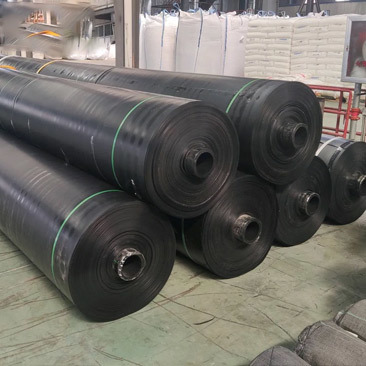Why Geomembrane Liners are Essential for Effective Site Management
Release time:
2025-10-04
Why Geomembrane Liners are Essential for Effective Site Management In the rapidly evolving world of construction and environmental management, effective site management is paramount to ensure safety, compliance, and sustainability. One of the unsung heroes in this domain is the geomembrane liner. These synthetic materials are critical for various applications, from waste containment to groundwater
Why Geomembrane Liners are Essential for Effective Site Management
In the rapidly evolving world of construction and environmental management, effective site management is paramount to ensure safety, compliance, and sustainability. One of the unsung heroes in this domain is the geomembrane liner. These synthetic materials are critical for various applications, from waste containment to groundwater protection. In this article, we will delve into why geomembrane liners are not just beneficial but essential for effective site management.
Understanding Geomembrane Liners
Geomembranes are impermeable membranes made from synthetic materials, primarily used for containment and separation in various engineering applications. They are crafted from materials like high-density polyethylene (HDPE), low-density polyethylene (LDPE), and polyvinyl chloride (PVC).
Types of Geomembrane Liners
1. **High-Density Polyethylene (HDPE) Liners:** Known for their strength and durability, HDPE liners are widely used in landfills and waste containment systems.
2. **Low-Density Polyethylene (LDPE) Liners:** More flexible than HDPE, LDPE is often utilized in applications requiring intricate shapes.
3. **Polyvinyl Chloride (PVC) Liners:** PVC liners offer excellent chemical resistance and are often used in agricultural and aquaculture applications.
4. **Reinforced Polypropylene Liners:** These liners provide added strength and are ideal for projects needing enhanced durability.
The Benefits of Using Geomembrane Liners
Implementing geomembrane liners offers numerous advantages that contribute directly to efficient site management.
1. Enhanced Containment
One of the primary functions of geomembrane liners is to provide a reliable containment barrier. Whether used in landfills, ponds, or storage facilities, these liners effectively prevent the escape of liquids and gases, protecting the surrounding environment.
2. Groundwater Protection
Pollution of groundwater sources can have devastating impacts. Geomembrane liners play a critical role in safeguarding aquifers by preventing contaminants from permeating through the soil. This protection is especially vital for industrial sites and landfills.
3. Cost-Effectiveness
While the initial investment in geomembrane liners may seem significant, they can lead to substantial cost savings in the long run. By minimizing leakage and ensuring compliance with environmental regulations, organizations avoid potential fines and remediation costs.
4. Versatility of Applications
Geomembrane liners are not limited to one specific use. They are utilized across various industries, including:
- **Landfill Engineering**
- **Mining Operations**
- **Agricultural Applications**
- **Water Management Projects**
- **Wastewater Treatment Facilities**
5. Long-Term Durability
Constructed from robust materials, geomembrane liners are designed to withstand harsh environmental conditions. Their resistance to punctures, UV radiation, and chemical exposure ensures longevity, providing peace of mind for site managers.
How Geomembrane Liners Contribute to Sustainable Practices
Sustainability is a key consideration in modern site management. Geomembrane liners contribute to sustainable practices in several ways.
1. Reduced Environmental Impact
By preventing leaks and spills, geomembrane liners significantly reduce the environmental footprint of construction and industrial activities.
2. Promoting Recycling and Reuse
Certain types of geomembrane liners can be recycled at the end of their lifecycle, aligning with circular economy principles and reducing waste.
3. Supporting Green Certifications
Utilizing geomembrane liners can help projects achieve green building certifications, as they demonstrate a commitment to environmental protection and sustainability.
Best Practices for Installation and Maintenance of Geomembrane Liners
To maximize the benefits of geomembrane liners, proper installation and maintenance are crucial.
1. Site Preparation
Before installation, thorough site preparation is necessary. This includes:
- **Removing Sharp Objects:** Clear the area of any debris that could puncture the liner.
- **Proper Grading:** Ensure the site is graded correctly to facilitate drainage and prevent water pooling.
2. Installation Techniques
Employ the following techniques for effective installation:
- **Seam Welding:** Use appropriate welding techniques to form secure joints, ensuring the integrity of the liner.
- **Testing for Leaks:** Conduct thorough testing post-installation to identify any potential leaks.
3. Regular Inspections
Establish a routine inspection schedule to assess the condition of the liners. Look for:
- **Punctures or Tears:** Identify and repair any damage promptly.
- **Chemical Resistance:** Ensure that the materials used are still suitable for the substances contained.
Challenges and Considerations in Geomembrane Usage
While geomembrane liners are effective, several challenges must be addressed.
1. Environmental Conditions
Extreme weather conditions can affect the performance of geomembrane liners. It is essential to select materials that can withstand local environmental factors.
2. Compatibility with Contaminants
Not all geomembranes are suitable for every application. It's crucial to ensure compatibility between the geomembrane material and the substances it will contain.
3. Installation Complexity
The installation of geomembrane liners can be complex, requiring skilled labor and specialized equipment. Proper training and adherence to best practices are vital.
Conclusion
Geomembrane liners are essential components in effective site management, offering unparalleled benefits in containment, groundwater protection, and sustainability. By understanding their advantages, applications, and best practices, site managers can optimize their use, ensuring compliance with environmental regulations and contributing to safer, greener construction practices. As the construction industry continues to evolve, the role of geomembrane liners will undoubtedly become even more critical, reinforcing their status as indispensable tools in modern site management.
Frequently Asked Questions (FAQs)
1. What are geomembrane liners made from?
Geomembrane liners are typically made from synthetic materials such as HDPE, LDPE, PVC, and reinforced polypropylene.
2. How are geomembrane liners installed?
Geomembrane liners are installed by preparing the site, laying the liner, welding seams, and conducting leak tests to ensure quality.
3. What applications do geomembrane liners serve?
Geomembrane liners are used in landfills, mining, agriculture, water management, and wastewater treatment facilities.
4. Are geomembrane liners environmentally friendly?
Yes, geomembrane liners help protect the environment by preventing leaks and can be recycled at the end of their lifecycle.
5. How can I maintain geomembrane liners?
Regular inspections and prompt repairs of any punctures or tears, along with ensuring chemical compatibility, will help maintain geomembrane liners effectively.






